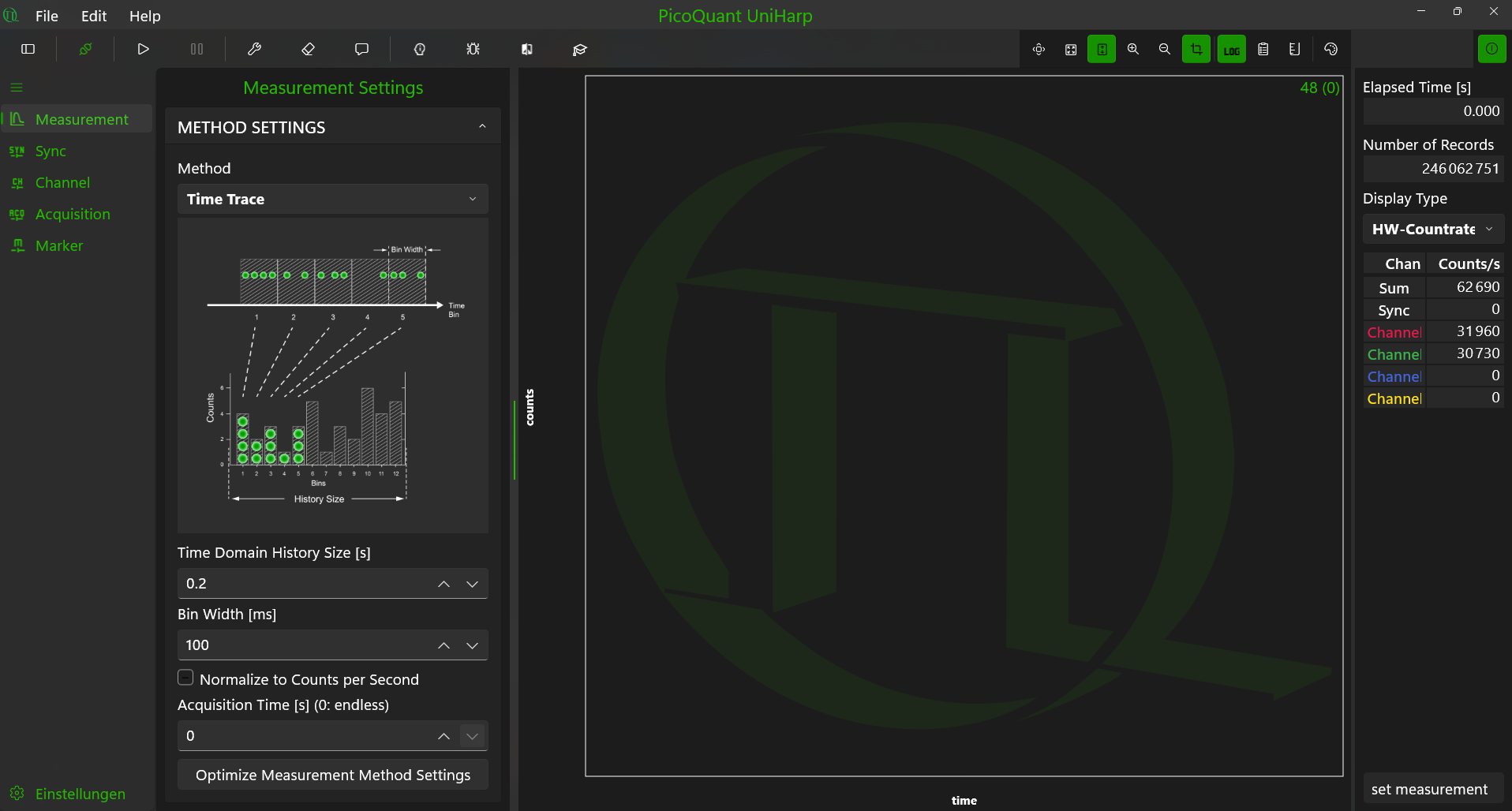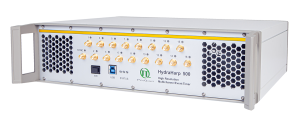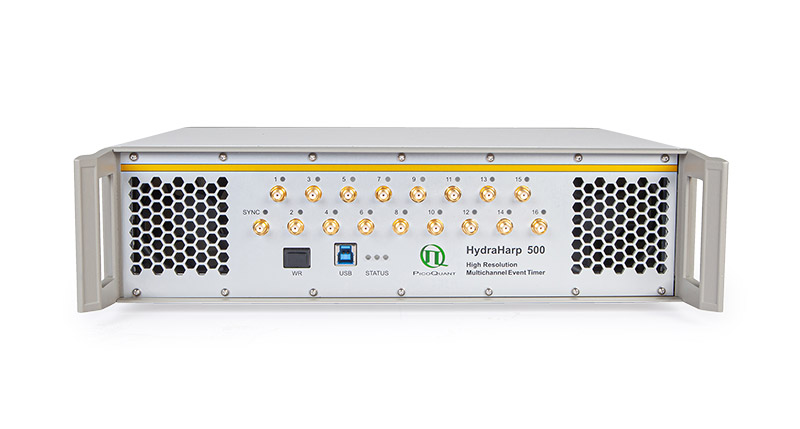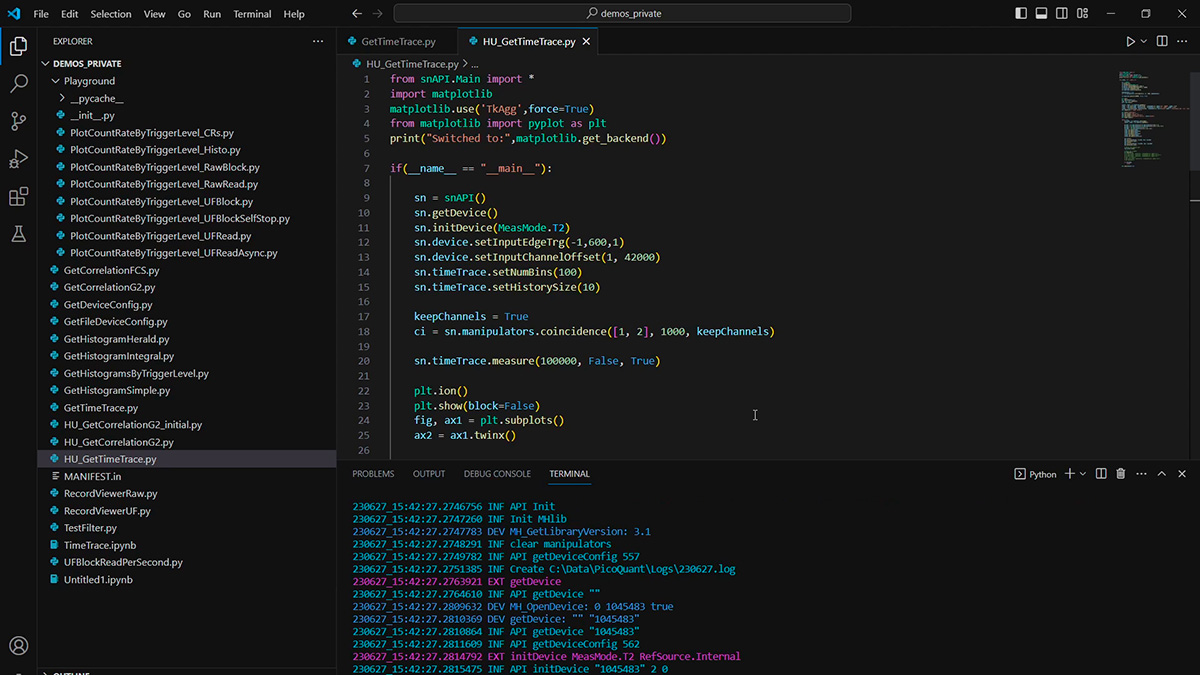TCSPC and Time Tagging Electronics
HydraHarp 500 NEW
High-Resolution Multichannel Event Timer & TCSPC Unit
HydraHarp 500 is a high-accuracy time tagger and TCSPC unit with picosecond timing precision. Featuring versatile trigger methods and multiple interfaces, it is perfectly suited for demanding applications that require many input channels and high data throughput.
- Outstanding timing precision of 2 ps RMS for single channel, 3 ps RMS between channels
- Cutting-edge time resolution of 1 ps
- Scalable up to 16+1 channels with advanced channel configuration
- Choice of edge triggers or Constant Fraction Discriminators (CFD) possible
- Sustained time tagging with up to 85 Mcps via USB 3.0 and high speed data link through eFPGA interface
- Ultrashort dead time of 680 ps, no dead time across channels
- Multifunctional on-board event filters
- Ref In/Ref Out/PPS In/White Rabbit interface for multi-device synchronization
Contact us to get a quote and for further questions.
Why choose HydraHarp 500?
FAST
High data throughput with up to 16+1 fully independent channels and an extremely low dead-time per channel with no dead time across channels.
PRECISE
Outstanding timing precision and picosecond accuracy, powered by a high-precision internal clock and exceptionally low jitter.
FLEXIBLE
Versatile channel configurations and trigger options for a wide range of detectors; includes USB 3.0, external FPGA interface, and White Rabbit for efficient data transfer and synchronization.
 A time tagger designed for researchers who demand the best combination of precision, flexibility, and efficiency
A time tagger designed for researchers who demand the best combination of precision, flexibility, and efficiency
The HydraHarp 500 integrates exceptional speed, precision, and flexibility to meet the requirements of cutting-edge research applications. With its ability to handle high-throughput experiments, deliver picosecond-level timing resolution, and supports different device configurations, it sets new standards in time-correlated single photon counting and event timing. Designed for reliability and seamless integration, the HydraHarp 500 excels in diverse fields, e.g. quantum optics or materials science, ensuring accurate and reproducible results even in demanding environments.
Benefits
- Accurate data you can trust with high data quality
- Flexibility in instrumentation
- High effectiveness/increased productivity
- Headroom to improve with additional FPGA for advanced users
- More complete dataset with less blindspots
- Makes experimental setup easier
- More available channels
- Connect devices to add more channels/enable long distance measurements
Step into the future of photonics and quantum research with the HydraHarp 500.
Contact us to get a quote and for further questions >
Prelimenary specifications of the HydraHarp 500 models
| HydraHarp 500 S | HydraHarp 500 M | |
|---|---|---|
| Input Channels and Sync | Individiual software adjustable CFD or edge trigger on all inputs | Edge trigger on all inputs |
| Number of detector channels (in addition to Sync input) |
4 (Base model) for HydraHarp 500 S; 5-8 (Base model + channel upgrades) | 8 (Base model) for HydraHarp 500 M ; 9-16 (Base model + channel upgrades) |
| Input voltage operating range (pulse peak into 50 Ohms) | -1500 mV to 1500 mV | |
| Input voltage max. range (damage level) | - 2000 mV to 3000 mV | |
| Trigger edge | CFD: falling edge / edge trigger: falling or rising edge, software adjustable | |
| Time to Digital Converters | ||
| Minimum time bin width | 1 ps | |
| Timing precision* | 3 ps rms typ. | |
| Timing precision / √2* | 2 ps rms typ. | |
| Dead time | 680 ps for edge trigger, 4.2 ns with CFD | |
| Differential non-linearity | < 6 % peak, < 0.9 % rms (over full measurement range) | |
| Maximum sync rate (periodic pulse train) | 640 MHz | |
| Histogrammer | ||
| Count depth | 32 bit (4 294 967 295 counts) | |
| Maximum number of time bins | 65536 (via GUI), 524288 (via DLL) | |
| TTTR Engine | ||
| Peak count rate per input channel | 1.47 × 109 cps for burst durations up to 1000 events | |
| Sustained count rate per input channel** | 80 Mcps | |
| Total sustained count rate, sum over all input channels** | 85 Mcps | |
| External Marker Inputs | ||
| Number | 4 | |
| External Synchronization | ||
| Ref IN | 10 MHz, 100 MHz, or 500 MHz 200 … 1500 mV p.p. 50 Ohm; AC coupled |
|
| Ref OUT | Default: 10 MHz 1000 mV 50 Ohm; DC coupled |
|
* In order to determine the timing precision it is necessary to repeatedly measure a time difference and to calculate the standard deviation (rms error) of these measurements. This is done by splitting an electrical signal from a pulse generator and feeding the two signals each to a separate input channel. The differences of the measured pulse arrival times are calculated along with the corresponding standard deviation. This latter value is the rms jitter which we use to specify the timing precision. However, calculating such a time difference requires two time measurements. Therefore, following from error propagation laws, the single channel rms error is obtained by dividing the previously calculated standard deviation by √(2). We also specify this single channel rms error here for comparison with other products.
** Sustained throughput depends on configuration and performance of host PC.
Contact us to get a quote and for further questions >
All Information given here is reliable to our best knowledge. However, no responsibility is assumed for possible inaccuracies or omissions. Specifications and external appearances are subject to change without notice.
Outstanding time resolution and timing precision
The smartly designed time-to-digital converters of the HydraHarp 500 with 1 ps base resolution, a jitter of 2 ps RMS (single channel) and 3 ps RMS (between channels),as well as < 680 ps dead time) allow to fully exploit the count rate limits of TCSPC, without having to compromise on the time resolution and precision for many modern single photon detectors.
With its ultrashort dead time, multiple photons per excitation cycle can be detected even at the highest repetition rates achievable by modern picosecond pulsed lasers (requires a detector from the PMA Hybrid Series).
The HydraHarp 500 also features a very high precision internal clock source with a frequency accuracy of ±300 ppb and a frequency stability of ±10 ppb.
more ...
Flexible channel configuration and synchronization
The HydraHarp 500 is equipped with up to 16 identical detection channels and an additional synchronization channel, providing the choice between 4+1 to 8+1 with CFD and edge trigger or 8+1 up to 16+1 with edge trigger only for input and synchronization purposes, adapting to your needs.
These channels are synchronized yet independent. The common sync channel which supports up to 640 MHz ensures seamless integration with an excitation source. If no synchronization is required, the sync input can be used as an additional detection channel. This feature facilitates tasks such as coincidence correlation or coincidence counting. The HydraHarp 500 is also ideally suited for performing TCSPC with multiple detectors using forward start-stop operation.R
more ...
User selectable trigger method
In order to support the widest possible variety of single photon detectors, the HydraHarp 500 provides software-configurable input circuitry. For optimal timing with e.g. Superconducting Nanowire Single Photon Detectors (SNSPD) the inputs can be configured as edge triggers while for best performance with Hybrid Photodetectors (HPD) or Micro Channel Plates (MCP) they can be configured as Constant Fraction Discriminators (CFD).
This way the overall system IRF may be tuned to become narrower. The same could not be achieved with a simple level trigger (comparator). Particularly with PMTs and MCPs, constant fraction discrimination is very important as their pulse amplitudes vary significantly.
more ...
High data throughput and ultrashort dead time
The design of the HydraHarp 500 allows high measurement rates up to 85 million counts/sec over all channels (up to up to 80 million counts/sec per single channel) and provides a highly stable, crystal calibrated time resolution of 1 ps.
The ultra short dead time of 680 ps when using edge trigger allows to detect multiple photons per excitation cycle even at the highest repetition rates achievable by modern picosecond pulsed lasers (requires a detector from the PMA Hybrid Series).
Adjustable timing offsets for each input channel
The HydraHarp 500 offers 65536 histogram bins per input channel and allows to collect more than 4 billion counts (32 bits) per bin. Each input channel even has an internal adjustable timing offsets (delay) with ±100 ns range at 1 ps resolution. This unique feature eliminates the need for specially adapted cable lengths or cable delays for different experimental set-ups.
Multifunctional on-board event filters
The HydraHarp 500 has user-defineable on-board event filters to efficiently reduce the file sizes and the amount of data sent via the USB interface.
Data interface for external FPGA boards
For applications with high count rates at multiple input channels, the data read-out speed and/or the data processing speed by the computer is the major bottleneck. This bottleneck can be bypassed by reducing the data size that is sent to the computer. Such a data reduction is for example done in the histogramming mode of the HydraHarp 500, where TCSPC histograms sent to the computer are calculated out of the arrival times of the input signals by the hardware itself.
To enable the greatest possible flexibility, the time tagging data stream of the HydraHarp 500 can be accessed by an external FPGA board via a dedicated FPGA interface. This way, the method of data preprocessing can be tailored to the specific application.
more ...
 White Rabbit ready event timer
White Rabbit ready event timer
White Rabbit is a fully deterministic, Ethernet-based timing network which provides sub-nanosecond accuracy and precise synchronization of devices over large distances. Thanks to its White Rabbit interface, the HydraHarp 500 is prepared to be used in networks that are based on this emerging technology.
Contact us to get a quote and for further questions >
Flexible control options for any application
The HydraHarp 500 offers three ways to control and operate the device, ensuring seamless integration into your workflow. Whether you need an easy-to-use software interface, a powerful Python-based API for fast programming, or fully customizable programming options, the HydraHarp 500 adapts to your needs.
Software with GUI
Free yet powerful device software for data acquisition and optional software for in-depth acquisition and analysis
API for fast programming
Fast, intuitive, and versatile Python-based API for efficient device communication, configuration, and data handling
Fully custom programming
A library for custom programming, e.g., with C, C#, LabVIEW, Matlab, and Python is available. Demo code is provided for an easy start.
Software with GUI
 The HydraHarp 500 includes a Windows software package with essential functions for setting parameters, displaying results, and managing the loading and saving of parameter settings and data curves. Key data, including count rate, maximum counts, position and peak width, are continuously displayed, supported by a comprehensive in-built help system which guides users in maximizing the capabilities of the HydraHarp 500. Additionally, the HydraHarp 500 is fully compatible with UniHarp, a sleek, powerful and intuitive graphical user interface. UniHarp revolutionize the interaction with PicoQuant’s TCSPC and Time Tagging Electronics, offering seamless access to advanced measurement modes like time trace, histogram, unfold, raw and correlation (including FCS and g²). It simplifies data acquisition and analysis for researchers in photonics, life science, materials science, and quantum optics. The GUI provides a streamlined interface to configure, initiate, and monitor your time tagger, ensuring every photon count is captured with precision. With intuitive parameter-setting tools UniHarp puts full control at your fingertips.
The HydraHarp 500 includes a Windows software package with essential functions for setting parameters, displaying results, and managing the loading and saving of parameter settings and data curves. Key data, including count rate, maximum counts, position and peak width, are continuously displayed, supported by a comprehensive in-built help system which guides users in maximizing the capabilities of the HydraHarp 500. Additionally, the HydraHarp 500 is fully compatible with UniHarp, a sleek, powerful and intuitive graphical user interface. UniHarp revolutionize the interaction with PicoQuant’s TCSPC and Time Tagging Electronics, offering seamless access to advanced measurement modes like time trace, histogram, unfold, raw and correlation (including FCS and g²). It simplifies data acquisition and analysis for researchers in photonics, life science, materials science, and quantum optics. The GUI provides a streamlined interface to configure, initiate, and monitor your time tagger, ensuring every photon count is captured with precision. With intuitive parameter-setting tools UniHarp puts full control at your fingertips.
API for Fast Programming
The HydraHarp 500 is compatible with the snAPI, a powerful Python wrapper that connects the high-speed capabilities of PicoQuant’s TCSPC and Time Tagging Electronics with the flexibility and ease of Python. Built on a robust C++ core, snAPI ensures optimal performance for seamless communication, efficient device configuration, and real-time data processing. It enables users to access unfolded data directly from TCSPC devices or read PTU files with ease, providing unparalleled flexibility for advanced data handling. With snAPI, researchers can create custom algorithms, perform complex calculations, and develop tailored data pipelines, unlocking deeper insights and innovative experimental workflows. Alternatives for advanced T2 data collection and analysis are the SymPhoTime and QuCoa software suites offered by PicoQuant. SymPhoTime is focused on typical life science applications while QuCoa is oriented towards typical quantum optics applications.
Fully Custom Programming
![]() For users requiring full customization, the HydraHarp 500 offers a comprehensive library supporting programming languages such as C, C#, LabVIEW, Matlab, and Python. This library allows researchers to create tailor-made solutions for specific experimental needs. Provided demo code ensures an easy start, while essential functions like setting parameters, displaying results, and managing data are readily accessible.
For users requiring full customization, the HydraHarp 500 offers a comprehensive library supporting programming languages such as C, C#, LabVIEW, Matlab, and Python. This library allows researchers to create tailor-made solutions for specific experimental needs. Provided demo code ensures an easy start, while essential functions like setting parameters, displaying results, and managing data are readily accessible.
PicoQuant's commitment to continuous software support ensures your custom workflows remain cutting-edge.
Contact us to get a quote and for further questions >
Expert Q&A: Exploring the HydraHarp 500
Learn how the HydraHarp 500 enables high-speed, high-precision photon timing for quantum optics and materials science in this expert interview.
Contact us to get a quote and for further questions >
The HydraHarp 500 can be used for various applications that can make use of a TCSPC and/or time tagging system with independent channels, such as:
- Time-Resolved Fluorescence
- Fluorescence Lifetime Imaging (FLIM)
- Phosphorescence Lifetime Imaging (PLIM)
- Fluorescence Correlation Spectroscopy (FCS)
- Fluorescence Lifetime Correlation Spectroscopy (FLCS)
- Foerster Resonance Energy Transfer (FRET)
- Stimulated Emission Depletion Microscopy (STED)
- Dual Focus Fluorescence Correlation Spectroscopy (2fFCS)
- Pulsed Interleaved Excitation (PIE)
- Fluorescence Anisotropy (Polarization)
- Singlet Oxygen
- Time-Resolved Photoluminescence (TRPL)
- Time-Resolved Cathodoluminescence
- Single Molecule Spectroscopy/DetectionTRPL Imaging
- Lanthanide Upconversion
- Bunch Purity
- LIDAR/Ranging/SLR
- Antibunching
- Coincidence Correlation
- Quantum Communication
- Quantum Entanglement
- Quantum Teleportation
- Quantum Information Processing
- Positron Annihilation Lifetime Spectroscopy (PALS)
- Thomas-Bollinger single photon method
- Diffuse Optical Tomography and Imaging
- Linear Optical Quantum Computation
- TD-fNIRS
- Multi-color Lifetime Imaging
- Intensity interferometry
- Time Interval Analysis (TIA)




 Contact us
Contact us
